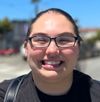Those Who Saw Value In Him Helped African-American Chemist Reach Career Heights
Charles George rounded out his career at the University of San Francisco, trying to develop procedures to help train chemistry students.

This article about Ingleside resident Charles George was written by Jan Robbins and published in Senior Beat, a collaboration between the nonprofit Community Living Campaign and the ReServe program.
Charles George had charisma, smarts and a purposeful nature. They propelled him through life despite the constraints of poverty and racism. He was shepherded along the way by people who valued his worth.
When George was born in 1923 in Wilmington, N.C., life was hardscrabble for most African Americans. “My father took jobs where he could find them – as a hotel bellman, a clerk, unloading at the dock,” George said. “Some days he’d bring home only a can of food or one dollar in pay.”
His mother added to the family income by teaching reading and math to children at home through a federally sponsored program. Together, his parents instilled in George principles of hard work and determination.
Go-Getter From The Get-Go
He was a go-getter from the time his father gave George, his eldest son, a parcel of the family’s backyard garden so he could grow his own vegetables. “Black families had their own gardens because they had little access to food,” he said. George sold the vegetables to white families in a neighborhood about a mile away.
“I learned about financial transactions through selling those vegetables,” George said. “They might offer a nickel and I’d counter with 10 cents.” George also earned money by cleaning a pharmacy and delivering medicine, cutting grass and assembling and delivering newspapers. “When assembling the papers, I didn’t get home until midnight two days a week.”
He got his first bike in a company contest for selling the most newspapers. “I rode that bike all over, stopping at restaurants to eat hot dogs and pie with the money I earned,” said George, who worked throughout high school.
He got top grades in chemistry and math, laying the foundation for a professional career. Although his grades other classes were “average,” his biology and chemistry teachers encouraged him to go to college. “I wanted to go to Tuskegee University because Mr. King (biology) went there and studied under George Washington Carver,” George said, “but it was a private school and I couldn’t get financial aid.”
A Challenging Start
George graduated instead from North Carolina’s Agricultural and Technical State College, where he majored in chemistry and minored in math – and got all As, he said. To cover his tuition, he did various odd jobs. In his junior year, he had a job spraying beetles for a man who urged him to apply at a commercial testing laboratory. George was skeptical a white firm would take him on, but they did. His first duties were menial, but soon they put him in the lab analyzing meat scrap and fertilizer, he said. “This was a very significant happening for me because I learned so much.”
Still, he wasn’t able to find a job as a chemist after college and marrying his college sweetheart. He taught chemistry at his alma mater for two years and high school science for one. When those positions ended, he had a nine-month stint at the U.S. Bureau of Mines in Raleigh. Then he went to work as a mail clerk at the railroad terminal in downtown Greensboro.
After six years, he found a job that would kickstart his career as a chemist with help from the American Friends Service Committee. Originally created to support WWI conscientious objectors, it later focused on ameliorating race relations. Now, George was analyzing metals at the U.S. Naval Metal Laboratory near Pittsburg, Pa. When that office closed, he was transferred to the Navy lab in Philadelphia. And when staff was reduced in Philadelphia, he was offered a job at the Navy shipyards in San Francisco.
Success And Discouragement
It was 1966 and George was 43. He didn’t find the environment particularly friendly. And when a co-worker told him his supervisor didn’t want a black man in his department, he said, he decided to look elsewhere for work. His next job was in the Meat Inspection Laboratory in the U.S. Department of Agriculture. He analyzed meat products and spices. After several years, he moved on to the U.S. Mint.
He would run into conflict there as well. In addition to assaying metals, he established a quality control program for inspections and started a chrome plating plant. He managed other department heads. Everything went well for 26 years, he said. But after returning from a work conference, he began suspecting an effort to get rid of him. He got negative feedback about his work. “All of a sudden I wasn’t good enough.”
George enlisted the aid of his daughter, a lawyer with contacts in Washington, D.C., to challenge his firing.
“She helped save my job,” George said, “but I got demoted.” He was able to retain his supervisor’s salary but being at retirement age — he decided leaving was for the best.
That was 1990. George was 67 but too full of energy to stop working.
“I went on all kinds of interviews and finally I was hired part-time by the University of San Francisco to manage their storeroom, where solutions were made and kept for the chemistry students.” After working there for 15 years, the position was scheduled to become full-time. But George wasn’t up for that.
A Chance To Experiment
Yet, when one of the chemistry professors offered to create a part-time job for him in the research lab, he decided to stay on. “I was paid for 10 hours but I usually worked 15 to 20 a week because I so enjoyed the work,” George said, “I was doing electro-chemistry research, which was like the chrome plating we did at the Mint.”
The two experimented with copper pennies, hoping to develop a procedure that high school and college chemistry students could use to learn electro-chemistry. “It didn’t work out because even the old pennies didn’t have enough copper,” George said, but “I live by the motto, ‘In the end you are not judged by what you did, but what you tried to do.’”
At 95, an arthritic knee forced him to finally retire.
In George’s early life, he tried many things, helped first by his father’s faith in him. Along the way, people stepped up to help him achieve his potential, he said. “People saw something in me early on that I might not have yet recognized in myself,” said George, now 97.
It’s been rough for George since his wife passed away two years ago, he said. But his daughter, who lives in the East Bay, visits him several days a week. And, he enjoys working in his garden. As far as his work history is concerned and despite some bad experiences, he said, “Looking back, it doesn’t feel like I worked a day in my life. I enjoyed it.”
Support independent community news
No media outlet covers our neighborhood like The Ingleside Light. Full stop.
Reader support sustains the expensive reporting our community needs and deserves. Will you join the hundreds of readers and become a member?







